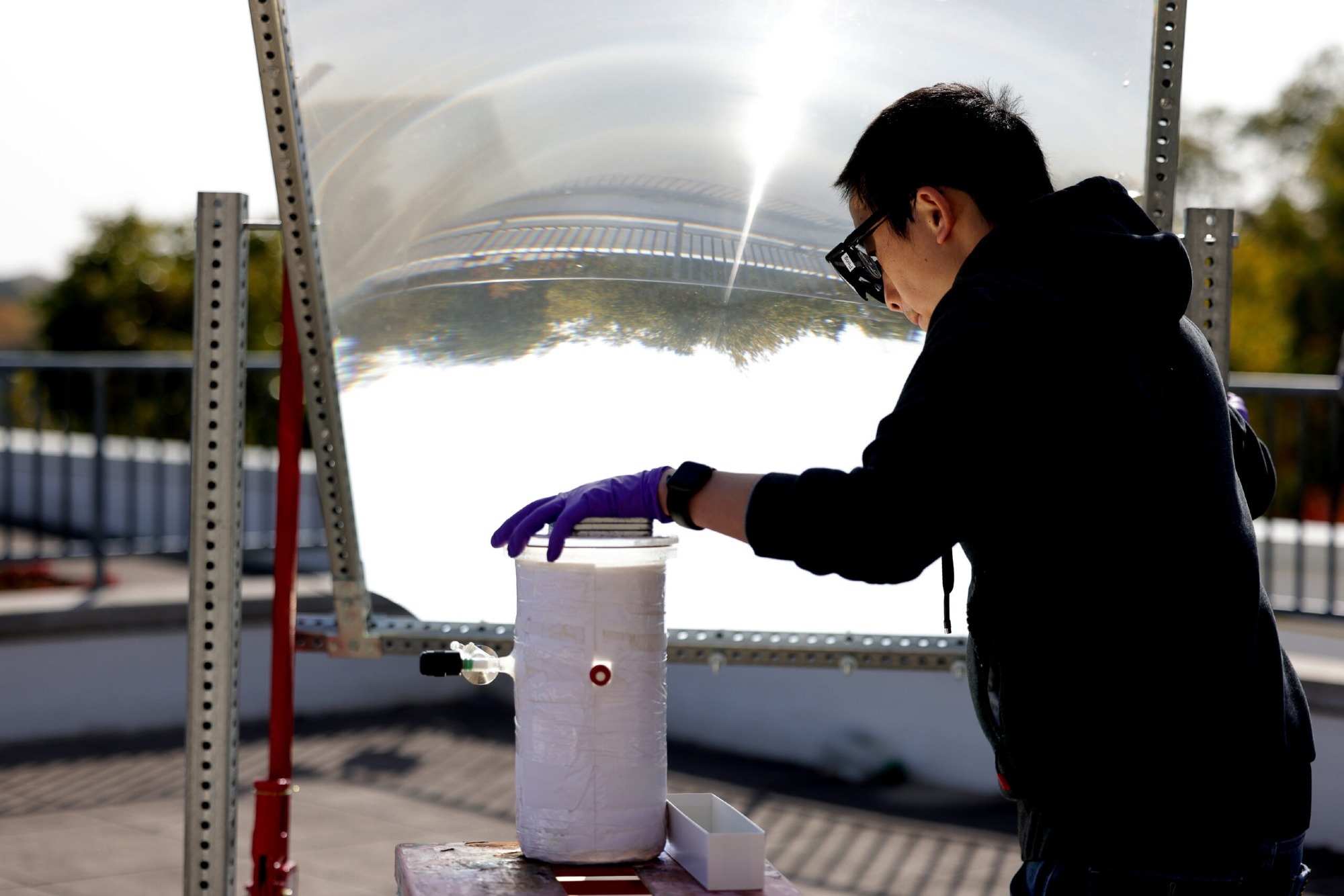Reviewed by Alex SmithJan 5 2023
At the University of Michigan, a new type of solar panel has achieved around 9% efficiency. This panel helps convert water into hydrogen and oxygen—copying a vital step in natural photosynthesis.

Peng Zhou uses a large lens to concentrate sunlight onto the water-splitting catalyst. Outdoors, the device was ten times more efficient than previous efforts at solar water splitting. Image Credit: Brenda Ahearn/Michigan Engineering, Communications and Marketing.
The solar panel is almost ten times highly efficient compared to solar water-splitting experiments of its type.
However, the biggest advantage is cutting down the cost of sustainable hydrogen. This is made possible by shrinking the semiconductor, normally the costliest part of the device. The self-healing semiconductor resists concentrated light that is comparable to 160 suns.
Hydrogen production requires a great deal of fossil energy involved in the process. However, plants can harvest hydrogen atoms from water with the help of sunlight.
Following efforts to decrease carbon emissions, hydrogen fuel is appealing as both an independent fuel and a component in sustainable fuels that have been created with recycled carbon dioxide. Hydrogen is also required for several chemical processes, including fertilizers production.
In the end, we believe that artificial photosynthesis devices will be much more efficient than natural photosynthesis, which will provide a path toward carbon neutrality.
Zetian Mi, Study Lead Author and Professor, Electrical and Computer Engineering, University of Michigan
The study has been reported in the Nature journal.
The success of the results comes from two progresses. The first is the potential to concentrate the sunlight without ruining the semiconductor that controls the light.
We reduced the size of the semiconductor by more than 100 times compared to some semiconductors only working at low light intensity. Hydrogen produced by our technology could be very cheap.
Peng Zhou, Study First Author and Research Fellow, Electrical and Computer Engineering, University of Michigan
Then, the second is making use of both the higher energy part of the solar spectrum to divide the water and the lower part of the spectrum to offer heat that helps promote the reaction. This helps withstand the degradation that such catalysts generally experience when they control sunlight for chemical reactions to be driven.
Besides tackling high light intensities, it has the potential to thrive in high temperatures that are laborious to computer semiconductors. Higher temperatures help expedite the water-splitting process, and the additional heat also promotes the hydrogen and oxygen to stay separate instead of renewing their bonds and developing water once more. Hence, both of these helped the group harvest additional hydrogen.
For the outdoor experiment to be performed, Zhou established a lens around the size of a house window to focus sunlight onto an experimental panel that is just a few inches throughout. Inside that panel, the semiconductor catalyst was made to be covered in a layer of water, resulting in the bubbling with the oxygen and hydrogen gasses it separated.
The catalyst is made with indium gallium nitride nanostructures, which are grown onto a silicon surface. A semiconductor wafer helps capture the light, transforming it into free holes and electrons—positively charged gaps that have been left behind while the electrons are being liberated by the light.
The nanostructures are dotted with nanoscale balls of metal, measuring around 1/2000th of a millimeter across, which use those holes and electrons to help direct the reaction.
An easy insulating layer on top of the panel maintains the temperature at a toasty 75 °C or 167 °F. This is considered to be highly warm to help promote the reaction while also being highly cool for the semiconductor catalyst to be executed well.
The experiment’s outdoor version, with less trustworthy sunlight and temperature, obtained around 6.1% efficiency at converting the energy from the sun into hydrogen fuel. But indoors, the system obtained around an efficiency of 9%.
The next difficulties the team plans to handle are to additionally enhance the efficiency and obtain ultrahigh purity hydrogen that could be fed directly into fuel cells.
Few of the intellectual property associated with this work has been licensed to NS Nanotech Inc. and NX Fuels Inc., which were co-founded by Mi. The University of Michigan and Mi show a financial interest in both companies.
This work was financially supported by the National Science Foundation, the Department of Defense, the Michigan Translational Research and Commercialization Innovation Hub, the Blue Sky Program in the College of Engineering at the University of Michigan and the Army Research Office.
A More Efficient Method for Harvesting Hydrogen
Video Credit: University of Michigan.
Journal Reference:
Zhou, P., et al. (2022) Solar-to-hydrogen efficiency of more than 9% in photocatalytic water splitting. Nature. doi.org/10.1038/s41586-022-05399-1.